stop start CHEVROLET KODIAK 2009 Owners Manual
[x] Cancel search | Manufacturer: CHEVROLET, Model Year: 2009, Model line: KODIAK, Model: CHEVROLET KODIAK 2009Pages: 376, PDF Size: 5.39 MB
Page 8 of 376
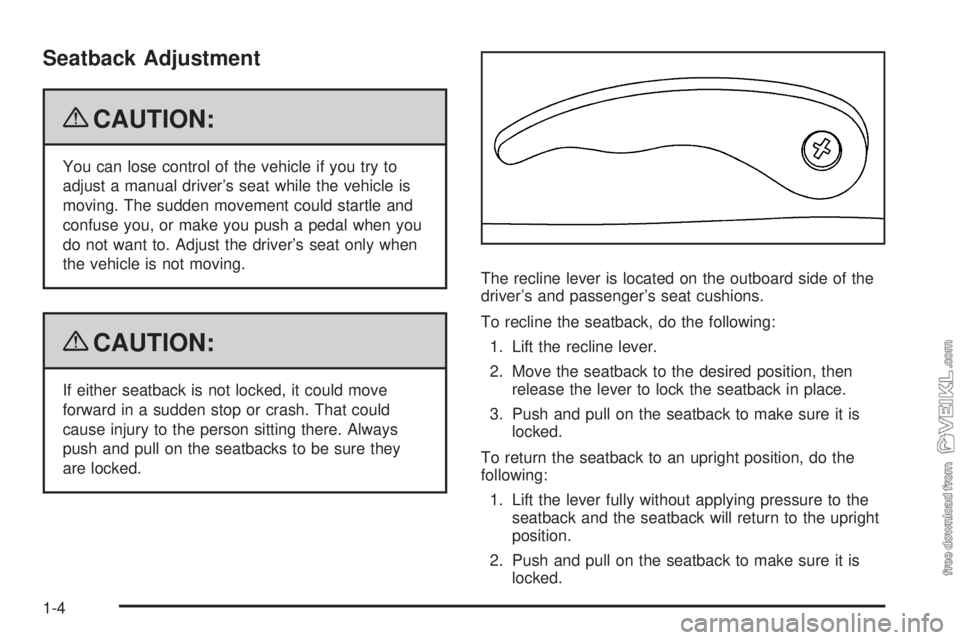
Seatback Adjustment
{CAUTION:
You can lose control of the vehicle if you try to
adjust a manual driver’s seat while the vehicle is
moving. The sudden movement could startle and
confuse you, or make you push a pedal when you
do not want to. Adjust the driver’s seat only when
the vehicle is not moving.
{CAUTION:
If either seatback is not locked, it could move
forward in a sudden stop or crash. That could
cause injury to the person sitting there. Always
push and pull on the seatbacks to be sure they
are locked.The recline lever is located on the outboard side of the
driver’s and passenger’s seat cushions.
To recline the seatback, do the following:
1. Lift the recline lever.
2. Move the seatback to the desired position, then
release the lever to lock the seatback in place.
3. Push and pull on the seatback to make sure it is
locked.
To return the seatback to an upright position, do the
following:
1. Lift the lever fully without applying pressure to the
seatback and the seatback will return to the upright
position.
2. Push and pull on the seatback to make sure it is
locked.
1-4
Page 74 of 376
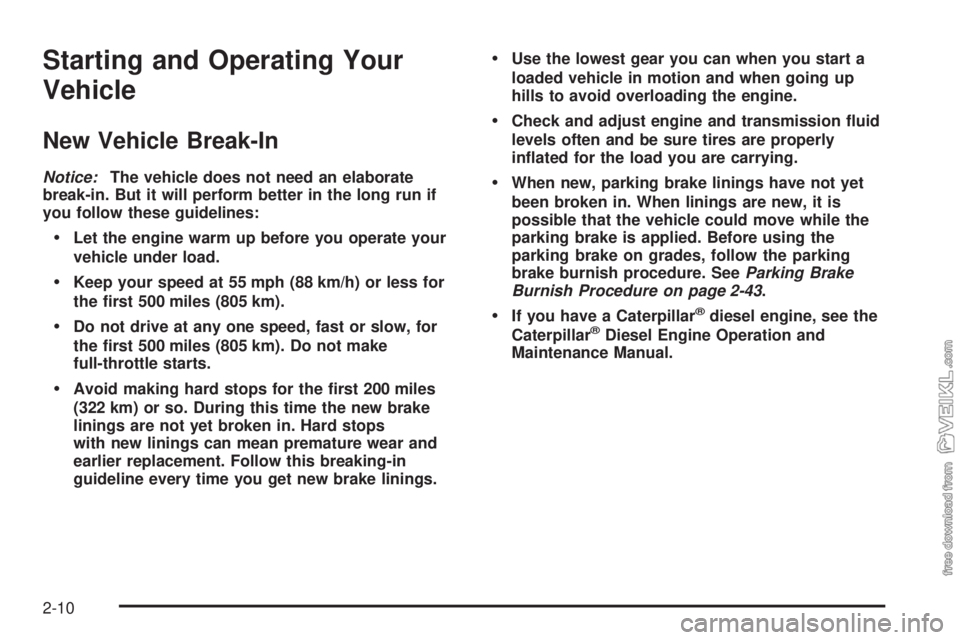
Starting and Operating Your
Vehicle
New Vehicle Break-In
Notice:The vehicle does not need an elaborate
break-in. But it will perform better in the long run if
you follow these guidelines:
•Let the engine warm up before you operate your
vehicle under load.
•Keep your speed at 55 mph (88 km/h) or less for
the first 500 miles (805 km).
•Do not drive at any one speed, fast or slow, for
the first 500 miles (805 km). Do not make
full-throttle starts.
•Avoid making hard stops for the first 200 miles
(322 km) or so. During this time the new brake
linings are not yet broken in. Hard stops
with new linings can mean premature wear and
earlier replacement. Follow this breaking-in
guideline every time you get new brake linings.
•Use the lowest gear you can when you start a
loaded vehicle in motion and when going up
hills to avoid overloading the engine.
•Check and adjust engine and transmission fluid
levels often and be sure tires are properly
inflated for the load you are carrying.
•When new, parking brake linings have not yet
been broken in. When linings are new, it is
possible that the vehicle could move while the
parking brake is applied. Before using the
parking brake on grades, follow the parking
brake burnish procedure. SeeParking Brake
Burnish Procedure on page 2-43.
•If you have a Caterpillar®diesel engine, see the
Caterpillar®Diesel Engine Operation and
Maintenance Manual.
2-10
Page 77 of 376
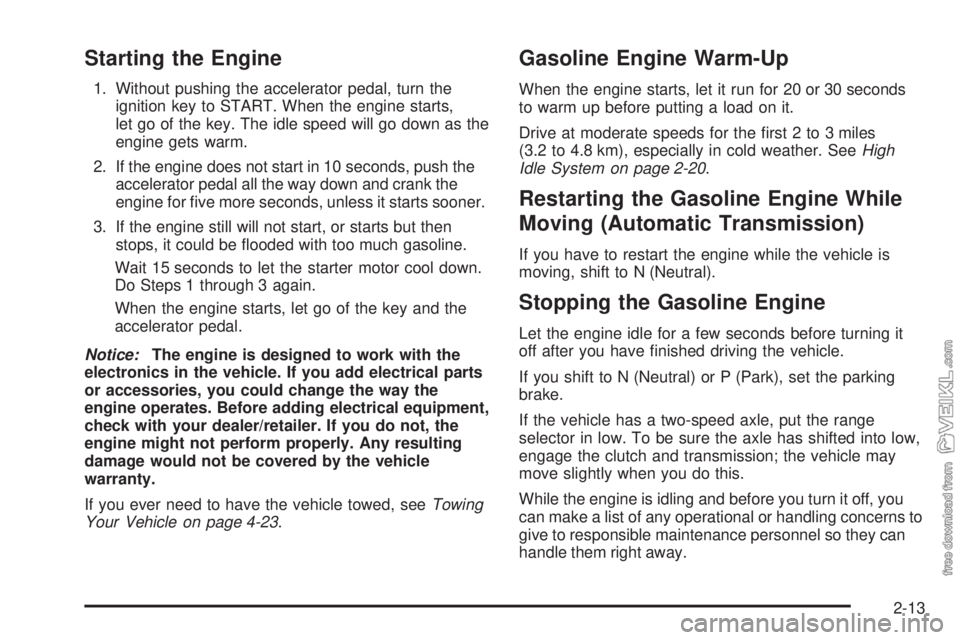
Starting the Engine
1. Without pushing the accelerator pedal, turn the
ignition key to START. When the engine starts,
let go of the key. The idle speed will go down as the
engine gets warm.
2. If the engine does not start in 10 seconds, push the
accelerator pedal all the way down and crank the
engine for five more seconds, unless it starts sooner.
3. If the engine still will not start, or starts but then
stops, it could be flooded with too much gasoline.
Wait 15 seconds to let the starter motor cool down.
Do Steps 1 through 3 again.
When the engine starts, let go of the key and the
accelerator pedal.
Notice:The engine is designed to work with the
electronics in the vehicle. If you add electrical parts
or accessories, you could change the way the
engine operates. Before adding electrical equipment,
check with your dealer/retailer. If you do not, the
engine might not perform properly. Any resulting
damage would not be covered by the vehicle
warranty.
If you ever need to have the vehicle towed, seeTowing
Your Vehicle on page 4-23.
Gasoline Engine Warm-Up
When the engine starts, let it run for 20 or 30 seconds
to warm up before putting a load on it.
Drive at moderate speeds for the first 2 to 3 miles
(3.2 to 4.8 km), especially in cold weather. SeeHigh
Idle System on page 2-20.
Restarting the Gasoline Engine While
Moving (Automatic Transmission)
If you have to restart the engine while the vehicle is
moving, shift to N (Neutral).
Stopping the Gasoline Engine
Let the engine idle for a few seconds before turning it
off after you have finished driving the vehicle.
If you shift to N (Neutral) or P (Park), set the parking
brake.
If the vehicle has a two-speed axle, put the range
selector in low. To be sure the axle has shifted into low,
engage the clutch and transmission; the vehicle may
move slightly when you do this.
While the engine is idling and before you turn it off, you
can make a list of any operational or handling concerns to
give to responsible maintenance personnel so they can
handle them right away.
2-13
Page 78 of 376

Moisture will condense in a fuel tank that is almost
empty if the engine has not run for a while, even just
overnight under some conditions. So, it is always best to
refuel the vehicle at the end of each run.
Starting the Diesel Engine
The vehicle’s diesel engine starts differently than a
gasoline engine. Read the following pages to learn how
to start, restart, warm-up, and stop the diesel engine.
The information applies to Caterpillar
®Diesel Engine,
6.6L DURAMAX®Diesel Engine, Isuzu 6H Diesel
Engine, unless otherwise noted.
If you have a Caterpillar
®Diesel Engine, also refer to
the Caterpillar®Diesel Engine Operation & Maintenance
Manual for the starting procedure.
Automatic Transmission
Move the shifter to P (Park) or N (Neutral). The engine
will not start in any other position. To restart the
engine when the vehicle is already moving, use
N (Neutral) only.
Notice:Do not try to shift to P (Park) if the
vehicle is moving. If you do, you could damage
the transmission. Shift to P (Park) only when
the vehicle is stopped.
Manual Transmission
Move the shift lever to N (Neutral) and hold the clutch
pedal to the floor while starting the engine. The vehicle
will not start if the clutch pedal is not all the way down.
Starting the Engine
1. Turn your ignition key to ON/RUN.
Observe the wait to start light. SeeWait to Start
Light on page 3-35. This light may not come
on if the engine is hot.
If you have a Caterpillar
®diesel engine, see your
Caterpillar®Diesel Engine Operation & Maintenance
Manual for proper wait to start light operation.
2. As soon as the wait to start light goes off,
immediately turn the ignition key to START.
When the engine starts, let go of the key.
If the vehicle is equipped with a DURAMAX
®
6600 Diesel Engine, it has a fast warm-up glow
plug system. The wait to start light will illuminate for
a much shorter time than most diesel engines,
due to the rapid heating of the glow plugs.
Notice:Holding the key in START for longer than
15 seconds at a time will cause the battery to
be drained much sooner. And the excessive heat
can damage the starter motor.
2-14
Page 80 of 376
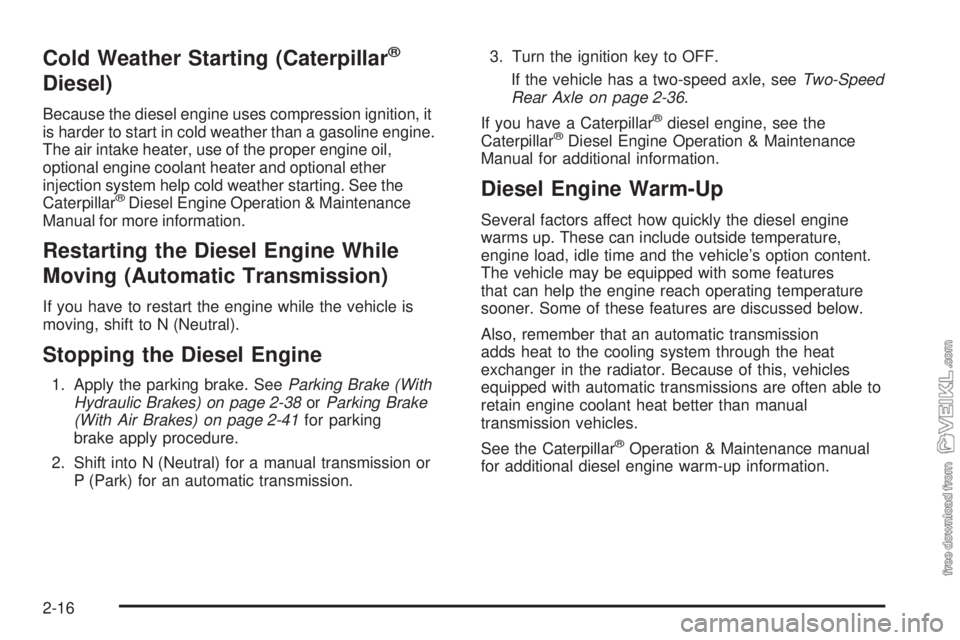
Cold Weather Starting (Caterpillar®
Diesel)
Because the diesel engine uses compression ignition, it
is harder to start in cold weather than a gasoline engine.
The air intake heater, use of the proper engine oil,
optional engine coolant heater and optional ether
injection system help cold weather starting. See the
Caterpillar
®Diesel Engine Operation & Maintenance
Manual for more information.
Restarting the Diesel Engine While
Moving (Automatic Transmission)
If you have to restart the engine while the vehicle is
moving, shift to N (Neutral).
Stopping the Diesel Engine
1. Apply the parking brake. SeeParking Brake (With
Hydraulic Brakes) on page 2-38orParking Brake
(With Air Brakes) on page 2-41for parking
brake apply procedure.
2. Shift into N (Neutral) for a manual transmission or
P (Park) for an automatic transmission.3. Turn the ignition key to OFF.
If the vehicle has a two-speed axle, seeTwo-Speed
Rear Axle on page 2-36.
If you have a Caterpillar
®diesel engine, see the
Caterpillar®Diesel Engine Operation & Maintenance
Manual for additional information.
Diesel Engine Warm-Up
Several factors affect how quickly the diesel engine
warms up. These can include outside temperature,
engine load, idle time and the vehicle’s option content.
The vehicle may be equipped with some features
that can help the engine reach operating temperature
sooner. Some of these features are discussed below.
Also, remember that an automatic transmission
adds heat to the cooling system through the heat
exchanger in the radiator. Because of this, vehicles
equipped with automatic transmissions are often able to
retain engine coolant heat better than manual
transmission vehicles.
See the Caterpillar
®Operation & Maintenance manual
for additional diesel engine warm-up information.
2-16
Page 81 of 376
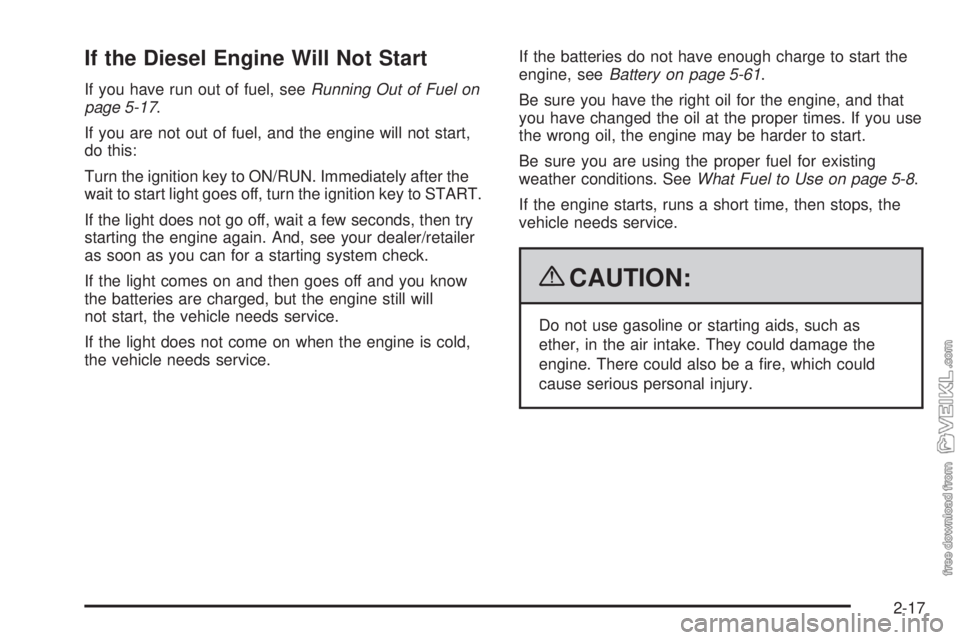
If the Diesel Engine Will Not Start
If you have run out of fuel, seeRunning Out of Fuel on
page 5-17.
If you are not out of fuel, and the engine will not start,
do this:
Turn the ignition key to ON/RUN. Immediately after the
wait to start light goes off, turn the ignition key to START.
If the light does not go off, wait a few seconds, then try
starting the engine again. And, see your dealer/retailer
as soon as you can for a starting system check.
If the light comes on and then goes off and you know
the batteries are charged, but the engine still will
not start, the vehicle needs service.
If the light does not come on when the engine is cold,
the vehicle needs service.If the batteries do not have enough charge to start the
engine, seeBattery on page 5-61.
Be sure you have the right oil for the engine, and that
you have changed the oil at the proper times. If you use
the wrong oil, the engine may be harder to start.
Be sure you are using the proper fuel for existing
weather conditions. SeeWhat Fuel to Use on page 5-8.
If the engine starts, runs a short time, then stops, the
vehicle needs service.
{CAUTION:
Do not use gasoline or starting aids, such as
ether, in the air intake. They could damage the
engine. There could also be a fire, which could
cause serious personal injury.
2-17
Page 83 of 376
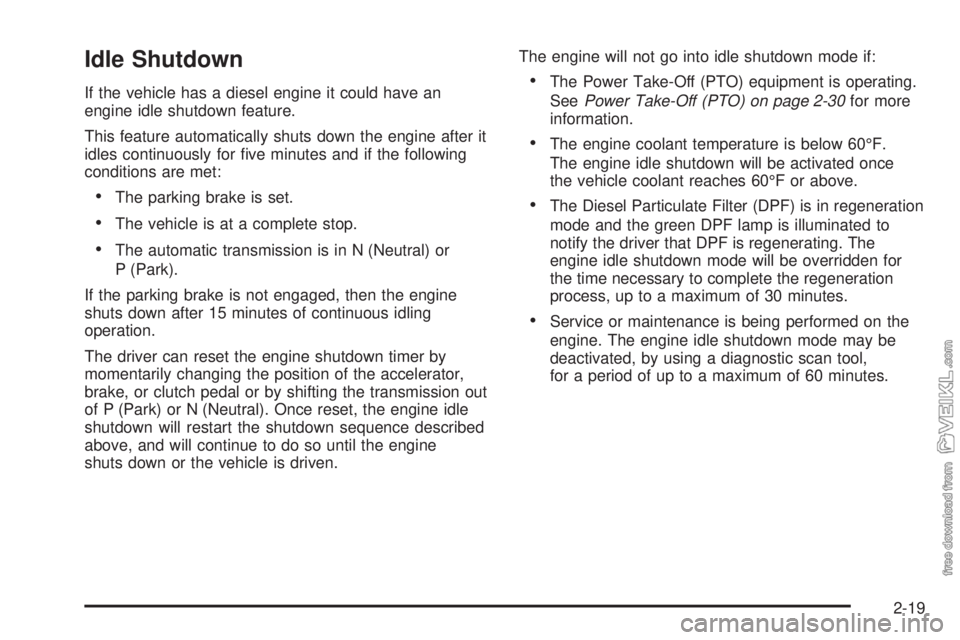
Idle Shutdown
If the vehicle has a diesel engine it could have an
engine idle shutdown feature.
This feature automatically shuts down the engine after it
idles continuously for five minutes and if the following
conditions are met:
•The parking brake is set.
•The vehicle is at a complete stop.
•The automatic transmission is in N (Neutral) or
P (Park).
If the parking brake is not engaged, then the engine
shuts down after 15 minutes of continuous idling
operation.
The driver can reset the engine shutdown timer by
momentarily changing the position of the accelerator,
brake, or clutch pedal or by shifting the transmission out
of P (Park) or N (Neutral). Once reset, the engine idle
shutdown will restart the shutdown sequence described
above, and will continue to do so until the engine
shuts down or the vehicle is driven.The engine will not go into idle shutdown mode if:
•The Power Take-Off (PTO) equipment is operating.
SeePower Take-Off (PTO) on page 2-30for more
information.
•The engine coolant temperature is below 60°F.
The engine idle shutdown will be activated once
the vehicle coolant reaches 60°F or above.
•The Diesel Particulate Filter (DPF) is in regeneration
mode and the green DPF lamp is illuminated to
notify the driver that DPF is regenerating. The
engine idle shutdown mode will be overridden for
the time necessary to complete the regeneration
process, up to a maximum of 30 minutes.
•Service or maintenance is being performed on the
engine. The engine idle shutdown mode may be
deactivated, by using a diagnostic scan tool,
for a period of up to a maximum of 60 minutes.
2-19
Page 85 of 376
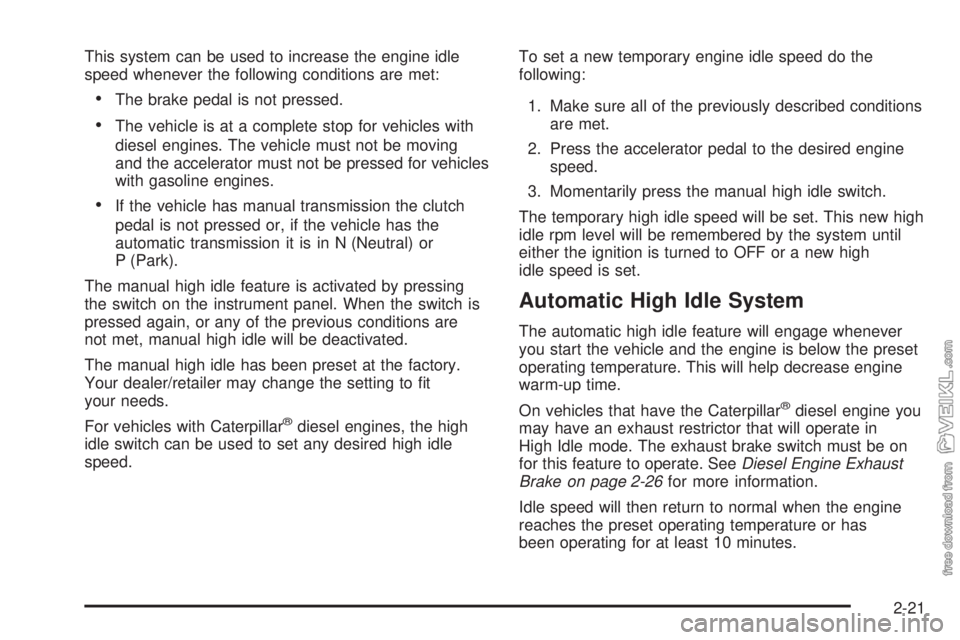
This system can be used to increase the engine idle
speed whenever the following conditions are met:
•The brake pedal is not pressed.
•The vehicle is at a complete stop for vehicles with
diesel engines. The vehicle must not be moving
and the accelerator must not be pressed for vehicles
with gasoline engines.
•If the vehicle has manual transmission the clutch
pedal is not pressed or, if the vehicle has the
automatic transmission it is in N (Neutral) or
P (Park).
The manual high idle feature is activated by pressing
the switch on the instrument panel. When the switch is
pressed again, or any of the previous conditions are
not met, manual high idle will be deactivated.
The manual high idle has been preset at the factory.
Your dealer/retailer may change the setting to fit
your needs.
For vehicles with Caterpillar
®diesel engines, the high
idle switch can be used to set any desired high idle
speed.To set a new temporary engine idle speed do the
following:
1. Make sure all of the previously described conditions
are met.
2. Press the accelerator pedal to the desired engine
speed.
3. Momentarily press the manual high idle switch.
The temporary high idle speed will be set. This new high
idle rpm level will be remembered by the system until
either the ignition is turned to OFF or a new high
idle speed is set.
Automatic High Idle System
The automatic high idle feature will engage whenever
you start the vehicle and the engine is below the preset
operating temperature. This will help decrease engine
warm-up time.
On vehicles that have the Caterpillar
®diesel engine you
may have an exhaust restrictor that will operate in
High Idle mode. The exhaust brake switch must be on
for this feature to operate. SeeDiesel Engine Exhaust
Brake on page 2-26for more information.
Idle speed will then return to normal when the engine
reaches the preset operating temperature or has
been operating for at least 10 minutes.
2-21
Page 88 of 376
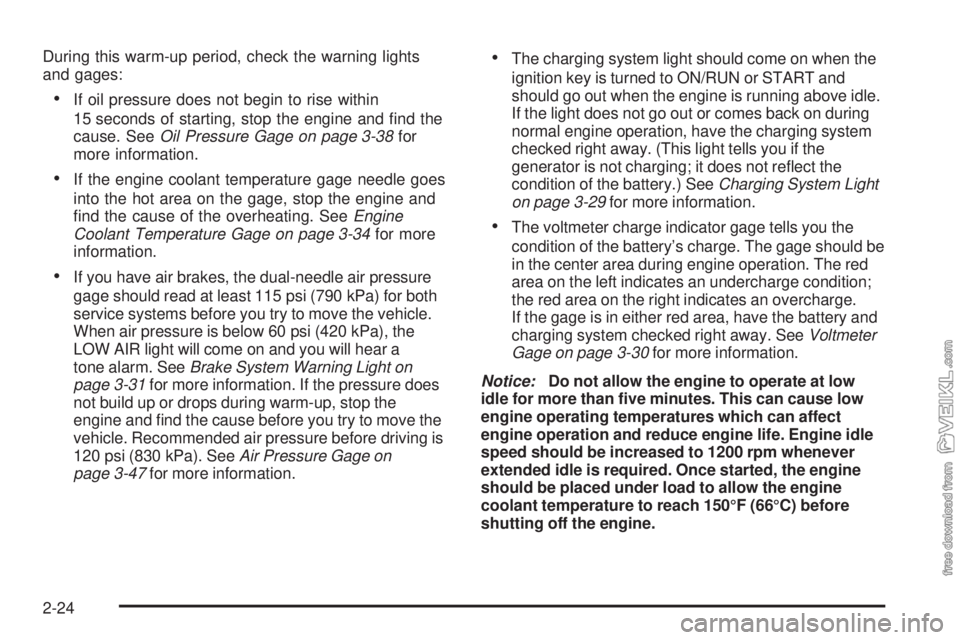
During this warm-up period, check the warning lights
and gages:
•If oil pressure does not begin to rise within
15 seconds of starting, stop the engine and find the
cause. SeeOil Pressure Gage on page 3-38for
more information.
•If the engine coolant temperature gage needle goes
into the hot area on the gage, stop the engine and
find the cause of the overheating. SeeEngine
Coolant Temperature Gage on page 3-34for more
information.
•If you have air brakes, the dual-needle air pressure
gage should read at least 115 psi (790 kPa) for both
service systems before you try to move the vehicle.
When air pressure is below 60 psi (420 kPa), the
LOW AIR light will come on and you will hear a
tone alarm. SeeBrake System Warning Light on
page 3-31for more information. If the pressure does
not build up or drops during warm-up, stop the
engine and find the cause before you try to move the
vehicle. Recommended air pressure before driving is
120 psi (830 kPa). SeeAir Pressure Gage on
page 3-47for more information.
•The charging system light should come on when the
ignition key is turned to ON/RUN or START and
should go out when the engine is running above idle.
If the light does not go out or comes back on during
normal engine operation, have the charging system
checked right away. (This light tells you if the
generator is not charging; it does not reflect the
condition of the battery.) SeeCharging System Light
on page 3-29for more information.
•The voltmeter charge indicator gage tells you the
condition of the battery’s charge. The gage should be
in the center area during engine operation. The red
area on the left indicates an undercharge condition;
the red area on the right indicates an overcharge.
If the gage is in either red area, have the battery and
charging system checked right away. SeeVoltmeter
Gage on page 3-30for more information.
Notice:Do not allow the engine to operate at low
idle for more than five minutes. This can cause low
engine operating temperatures which can affect
engine operation and reduce engine life. Engine idle
speed should be increased to 1200 rpm whenever
extended idle is required. Once started, the engine
should be placed under load to allow the engine
coolant temperature to reach 150°F (66°C) before
shutting off the engine.
2-24
Page 93 of 376
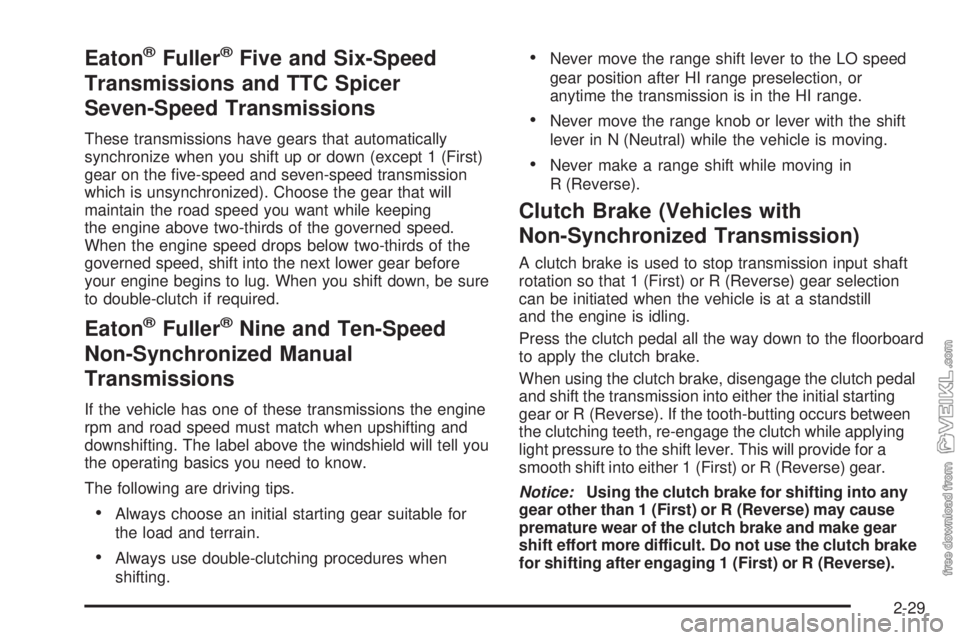
Eaton®Fuller®Five and Six-Speed
Transmissions and TTC Spicer
Seven-Speed Transmissions
These transmissions have gears that automatically
synchronize when you shift up or down (except 1 (First)
gear on the five-speed and seven-speed transmission
which is unsynchronized). Choose the gear that will
maintain the road speed you want while keeping
the engine above two-thirds of the governed speed.
When the engine speed drops below two-thirds of the
governed speed, shift into the next lower gear before
your engine begins to lug. When you shift down, be sure
to double-clutch if required.
Eaton®Fuller®Nine and Ten-Speed
Non-Synchronized Manual
Transmissions
If the vehicle has one of these transmissions the engine
rpm and road speed must match when upshifting and
downshifting. The label above the windshield will tell you
the operating basics you need to know.
The following are driving tips.
•Always choose an initial starting gear suitable for
the load and terrain.
•Always use double-clutching procedures when
shifting.
•Never move the range shift lever to the LO speed
gear position after HI range preselection, or
anytime the transmission is in the HI range.
•Never move the range knob or lever with the shift
lever in N (Neutral) while the vehicle is moving.
•Never make a range shift while moving in
R (Reverse).
Clutch Brake (Vehicles with
Non-Synchronized Transmission)
A clutch brake is used to stop transmission input shaft
rotation so that 1 (First) or R (Reverse) gear selection
can be initiated when the vehicle is at a standstill
and the engine is idling.
Press the clutch pedal all the way down to the floorboard
to apply the clutch brake.
When using the clutch brake, disengage the clutch pedal
and shift the transmission into either the initial starting
gear or R (Reverse). If the tooth-butting occurs between
the clutching teeth, re-engage the clutch while applying
light pressure to the shift lever. This will provide for a
smooth shift into either 1 (First) or R (Reverse) gear.
Notice:Using the clutch brake for shifting into any
gear other than 1 (First) or R (Reverse) may cause
premature wear of the clutch brake and make gear
shift effort more difficult. Do not use the clutch brake
for shifting after engaging 1 (First) or R (Reverse).
2-29